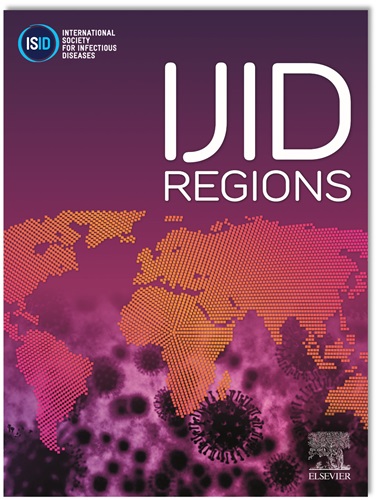Risk factors associated with Helicobacter pylori infection in the urban population of China: A nationwide, multi-center, cross-sectional study
IF 4.3
2区 医学
Q1 INFECTIOUS DISEASES
引用次数: 0
Abstract
Objectives
To assess the risk factors associated with Helicobacter pylori infection in the urban Chinese population.
Methods
The study was conducted from March to November 2023, including 12,902 urban participants aged 18-60 years across 52 cities distributed over 26 provinces in China. Risk factors included socioeconomic status, lifestyles, and public understanding. Univariate and multivariate logistic regression analysis was used to calculate corrected odds ratios (ORs) and 95% confidence intervals (CIs).
Results
According to multivariate logistic regression, risk factors associated with significantly higher H. pylori infection rates included residency in developing (OR 1.27, 95% CI 1.13-1.43) and undeveloped cities (OR 1.15, 95% CI 1.02-1.29), obesity (OR 1.37, 95% CI 1.05-1.78), alcohol consumption (OR 1.16, 95% CI 1.05-1.29), tea consumption (OR 1.11, 95% CI 1.01-1.21), and soft drink consumption (OR 1.24, 95% CI 1.09-1.40). Conversely, individuals with moderate awareness (OR 0.79, 95% CI 0.71-0.88) and high awareness (OR 0.57, 95% CI 0.48-0.69) of H. pylori had lower infection rates.
Conclusion
Our findings highlight the importance of promoting a healthy lifestyle and improving the understanding of H. pylori in reducing the infection rate of the bacterial pathogen in the urban Chinese population.
中国城市人群幽门螺杆菌感染相关危险因素:一项全国性、多中心、横断面研究
目的:探讨中国城市人群幽门螺杆菌感染的相关危险因素。方法:研究于2023年3月至11月进行,包括分布在中国26个省份的52个城市的18-60岁的12902名城市参与者。风险因素包括社会经济地位、生活方式和公众理解。采用单因素和多因素logistic回归分析计算校正优势比(ORs)和95%置信区间(ci)。结果:根据多因素logistic回归,与幽门螺杆菌感染率显著升高相关的危险因素包括居住在发展中城市(OR 1.27, 95% CI 1.13-1.43)和不发达城市(OR 1.15, 95% CI 1.02-1.29)、肥胖(OR 1.37, 95% CI 1.05-1.78)、饮酒(OR 1.16, 95% CI 1.05-1.29)、饮茶(OR 1.11, 95% CI 1.01-1.21)和软饮料消费(OR 1.24, 95% CI 1.09-1.40)。相反,幽门螺杆菌知知度中等(OR 0.79, 95% CI 0.71-0.88)和知知度较高(OR 0.57, 95% CI 0.48-0.69)的个体感染率较低。结论:我们的研究结果强调了促进健康生活方式和提高对幽门螺杆菌的认识对降低中国城市人群幽门螺杆菌感染率的重要性。
本文章由计算机程序翻译,如有差异,请以英文原文为准。
求助全文
约1分钟内获得全文
求助全文
来源期刊
CiteScore
18.90
自引率
2.40%
发文量
1020
审稿时长
30 days
期刊介绍:
International Journal of Infectious Diseases (IJID)
Publisher: International Society for Infectious Diseases
Publication Frequency: Monthly
Type: Peer-reviewed, Open Access
Scope:
Publishes original clinical and laboratory-based research.
Reports clinical trials, reviews, and some case reports.
Focuses on epidemiology, clinical diagnosis, treatment, and control of infectious diseases.
Emphasizes diseases common in under-resourced countries.

 求助内容:
求助内容: 应助结果提醒方式:
应助结果提醒方式:


